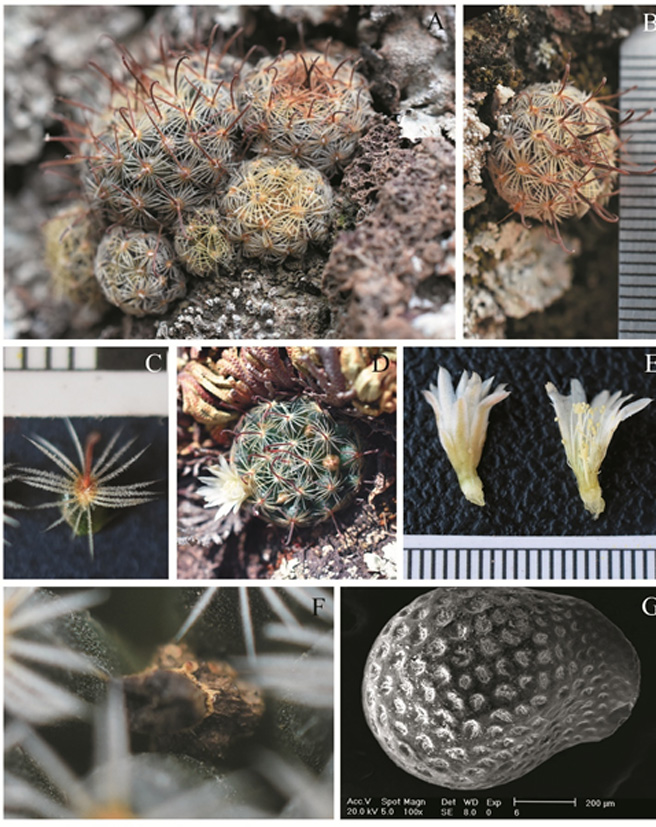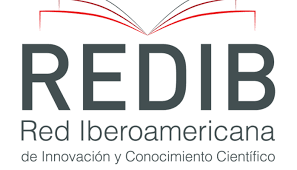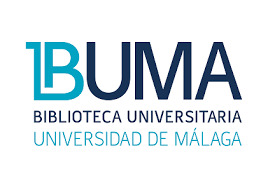Mammillaria scoria (Cactaceae) a new species from Querétaro, México
DOI:
https://doi.org/10.18387/polibotanica.60.1Palabras clave:
Cacteae, Linear Discriminant Analysis, Mammillaria crinita, Mammillaria nana, Mammillaria tezontle, morphometricsResumen
Mammillaria ser. Stylothelae es un grupo bien reconocido en el sur del Desierto Chihuahuense. Algunos miembros de esta serie has sido considerados como especies altamente polimórficas. Análisis recientes mostraron que algunas poblaciones de estos complejos de especies pueden ser aceptadas como especies independientes. En este estudio, analizamos y comparamos caracteres cuantitativos y cualitativos para identificar a una nueva especie. Comparamos el supuesto nuevo taxón con especies geográficamente y morfológicamente cercanas de la serie. Con base en nuestros resultados, describimos una especie endémica de M. ser. Stylothelae de Querétaro, México. El nuevo taxón es distintivo por su forma de crecimiento globosa, tamaño pequeño, el número de espinas centrales y radiales, presencia de raíces fibrosas, axilas desnudas y semillas sin arilo. Adicionalmente, se provee de información de su hábitat y estado de conservación preliminar para el nuevo taxón.
Referencias
Bachman, S., Moat, J., Hill, A. W., De La Torre, J., & Scott, B. (2011). Supporting Red List threat assessments with GeoCAT: geospatial conservation assessment tool. ZooKeys, 150(150), 117. DOI: https://doi.org/10.3897/zookeys.150.2109
Breslin, P., Wojciechowski M. F., & Majure L. (2021). Molecular phylogeny of the Mammilloid clade (Cactaceae) resolves the monophyly of Mammillaria. Taxon, 70(2), 308–323. DOI: https://doi.org/10.1002/tax.12451
Cervantes, C. R., Hinojosa-Álvarez, S., Wegier, A., Rosas, U., & Arias, S. (2021). Evaluating the monophyly of Mammillaria series Supertextae (Cactaceae). PhytoKeys, 177(177), 25–42. DOI: https://doi.org/10.3897/phytokeys.177.62915
Chincoya, D. A., Arias, S., Vaca-Paniagua, F., Dávila, P., & Solórzano, S. (2023). Phylogenomics and biogeography of the Mammilloid clade revealed an intricate evolutionary history arose in the Mexican Plateau. Biology, 12(4), 512. DOI: https://doi.org/10.3390/biology12040512
CETENAL. (1973a). Hoja Villa del Marqués (F-14-C-66), Querétaro. Secretaría de Programación y Presupuesto. Comisión de Estudios del Territorio Nacional (actualmente INEGI). Carta Geológica, escala 1:50000.
CETENAL. (1973b). Hoja Villa Hidalgo (F-14-A-74), San Luis Potosí. Secretaría de Programación y Presupuesto. Comisión de Estudios del Territorio Nacional (actualmente INEGI). Carta Geológica, escala 1:50000.
Fitz Maurice, W.A., & Fitz Maurice, B. (1995). Mammillaria tezontle sp. nov. Cactáceas y Suculentas Mexicanas, 40(3), 59–62.
Fitz Maurice, W.A., & Fitz Maurice, B. (1997). Fieldnotes – Mammillaria tezontle – a long-term study. Cactus and Succulent Journal. 69(4), 190–194.
Fitz Maurice, W.A., & Fitz Maurice, B. (2009). Stylothelae dilemmas, old and new. Cactus and Succulent Journal, 81(4), 210–213. DOI: https://doi.org/10.2985/015.081.0407
González-Zamora, P., Aquino, D., Mohl, J. & Sánchez, D. (2022). A new endemic species of Mammillaria (Cactaceae) from San Luis Potosí, México. Willdenowia, 52(3), 359–372. DOI: https://doi.org/10.3372/wi.52.52305
González-Zamora, P., Aquino, D., Rodríguez, A. & Sánchez, D. (2023). Mammillaria monochrysacantha (Cactaceae), a new endemic species from Guanajuato, México. Phytotaxa 618(3), 243–253. DOI: https://doi.org/10.11646/phytotaxa.618.3.2
Hammer, Ø., Harper, D. A. T., & Ryan, P. D. (2001). PAST: paleontological statistics software package for education and data analysis. Palaeontologia electrónica, 4(1), 1–9. DOI: https://palaeo-electronica.org/2001_1/past/issue1_01.htm
Hernández, H. M., & Gómez-Hinostrosa, C. (2015). Mapping the cacti of Mexico. Part II: Mammillaria. Milborne Port, UK: dh Books.
Hunt, D. R., Taylor, N. P., & Charles, G. (Eds.). (2006). The New Cactus Lexicon, text, and atlas. Milborne Port, UK: dh Books.
IUCN. (2024, July 19). Guidelines for using the International Union for Conservation of Nature Red List categories and criteria, Ver. 15.1. Retrieved from https://www.iucnredlist.org/resources/redlistguidelines.
Korotkova, N., Aquino, D., Arias, S., Eggli, U., Franck, A., Gómez-Hinostrosa, C., Guerrero, P., Hernández, H., Kohlbecker, A., Köhler, M., Luther, K., Majure, L., Müller, A., Metzing, D., Nyffeler, R., Sánchez, D., Schlumpberger, B., & Berendsohn. W. (2021). Cactaceae at Caryophyllales.org – a dynamic online species-level taxonomic backbone for the family. Willdenowia, 51(2), 251–270. DOI: https://doi.org/10.3372/wi.51.51208
Lüthy, J. M. 1995. Taxonomische Untersuchung der Gattung Mammillaria Haw. Ph.D. Dissertation, Universität Bern.
Ortiz-Brunel, J. P., Carrillo-Reyes, P., Sánchez, D., Ruíz-Sánchez, E., & Rodríguez, A. (2023). A morphological analysis of the Mammillaria fittkaui species complex (Cactaceae) reveals a new species from Jalisco, Mexico. Botanical Sciences, 101(2), 619–631. DOI: https://doi.org/10.17129/botsci.3221
Ortiz-Brunel, J.P. (2025). Evolución y biogeografía de Mammillaria serie Stylothelae (Cactaceae). Tesis de doctorado, Centro Universitario de Ciencias Biológicas y Agropecuarias. Universidad de Guadalajara.
Pilbeam, J. (1999). Mammillaria. The cactus handbook 6. Southampton, UK: Cirio Publishing Services.
Schneider C. A., Rasband, W. S. & Eliceiri, K. (2012). NIH Image to ImageJ: 25 years of image analysis. Nature Methods, 9(7), 671–675. DOI: https://doi.org/10.1038/nmeth.2089
Tabachnick, B. G., & Fidell, L. S. (2012). Using multivariate statistics (6th ed.). Boston, US: My Publisher.
Thiers, B. M. (2024, July 19). Index Herbariorum: A global directory of public herbaria and associated staff. Retrieved from http://sweetgum.nybg.org/ih/.

Descargas
Publicado
Licencia
Derechos de autor 2025 POLIBOTÁNICA

Esta obra está bajo una licencia internacional Creative Commons Atribución-NoComercial-CompartirIgual 4.0.

Polibotánica por Departamento de Botánica de la Escuela Nacional de Ciencias Biológicas del Instituto Politécnico Nacional se distribuye bajo una Licencia Creative Commons Atribución-NoComercial-CompartirIgual 4.0 Internacional.



















